
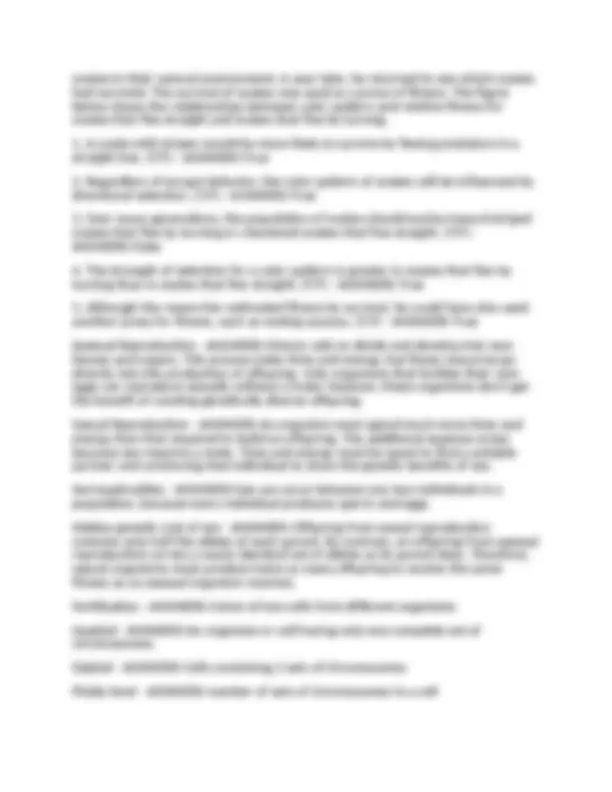
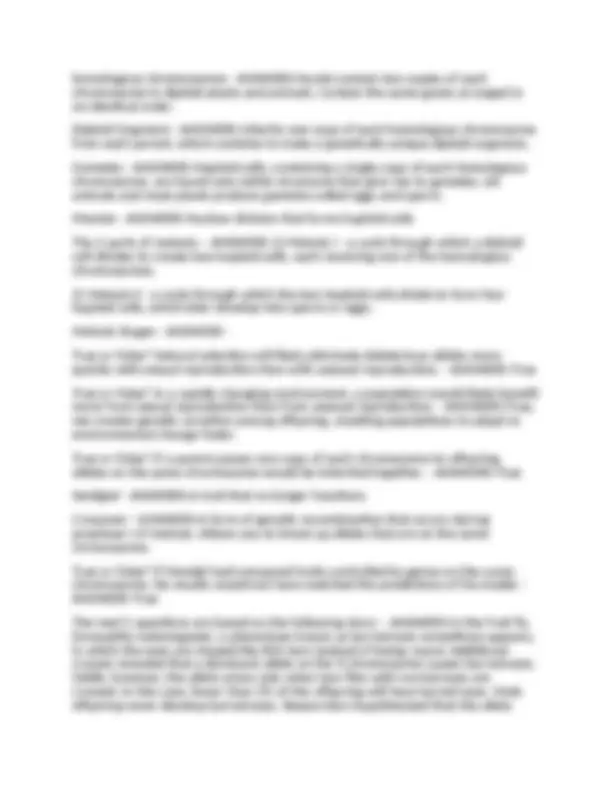
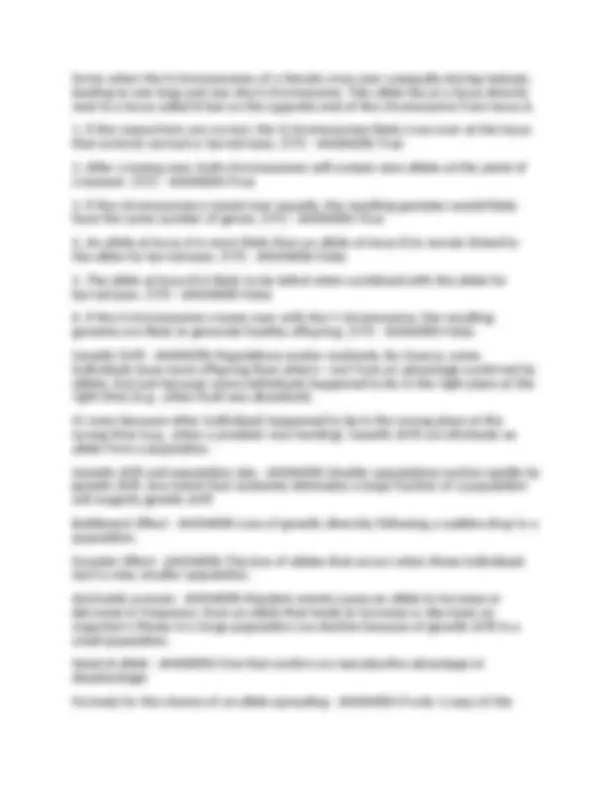
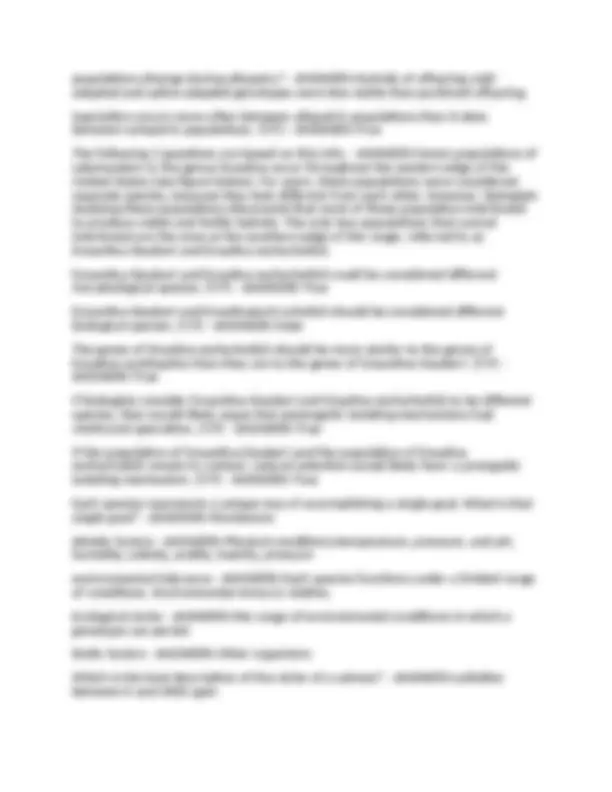

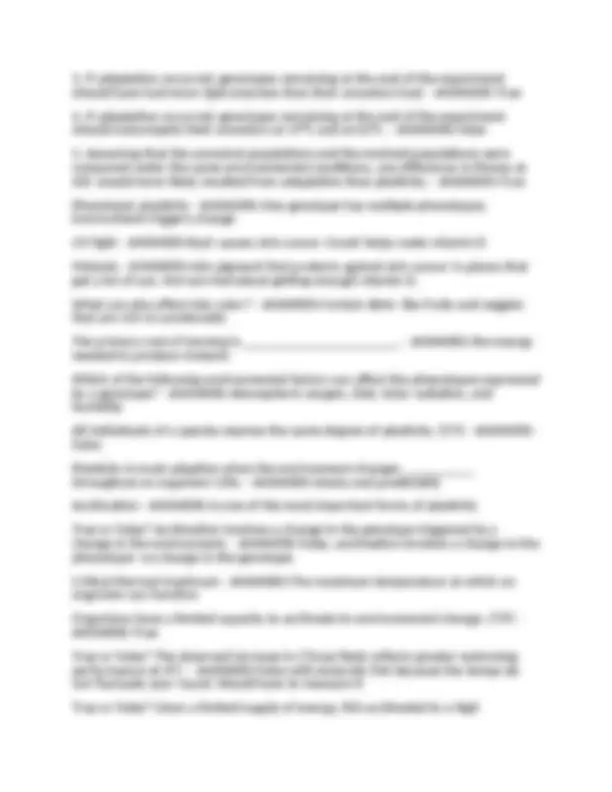
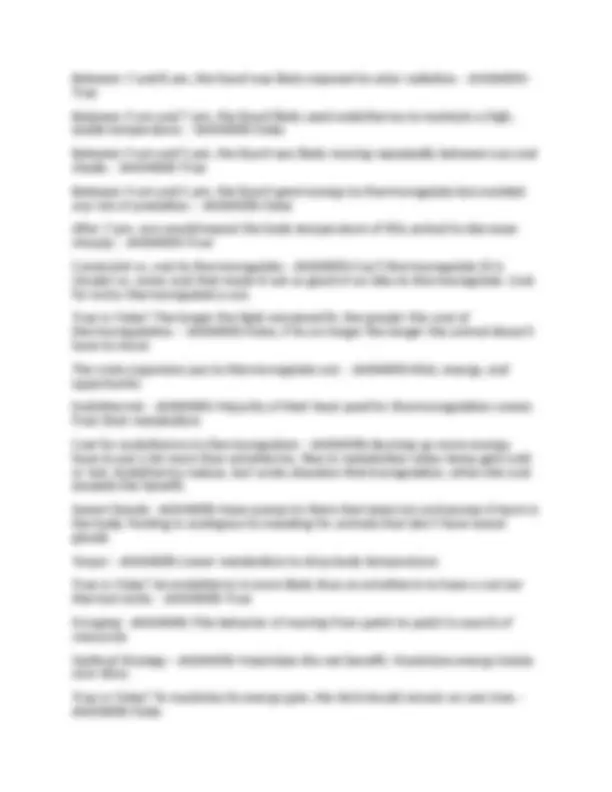
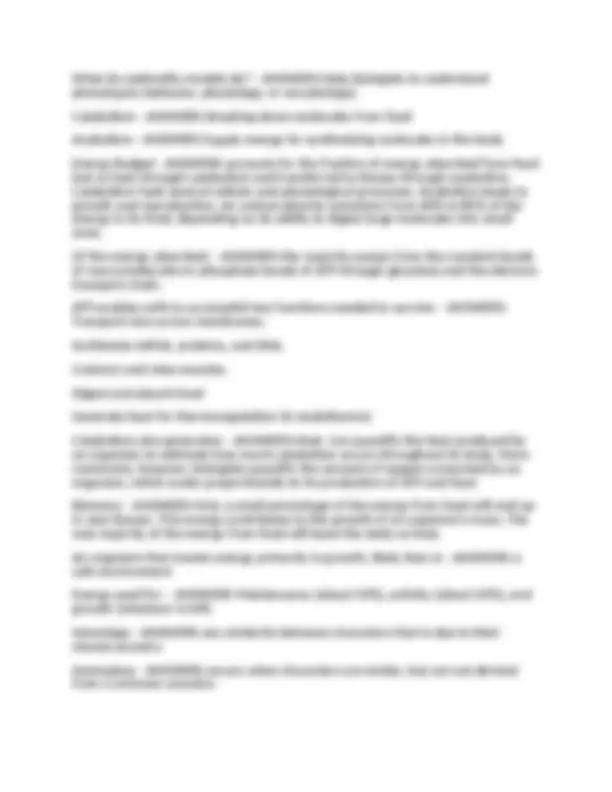


Study with the several resources on Docsity

Earn points by helping other students or get them with a premium plan


Prepare for your exams
Study with the several resources on Docsity

Earn points to download
Earn points by helping other students or get them with a premium plan
Community
Ask the community for help and clear up your study doubts
Discover the best universities in your country according to Docsity users
Free resources
Download our free guides on studying techniques, anxiety management strategies, and thesis advice from Docsity tutors
ASU BIO 182 EXAM 2 QUESTIONS WITH COMPLETE SOLUTIONS 2025 GRADED A+. ASU BIO 182 EXAM 2 QUESTIONS WITH COMPLETE SOLUTIONS 2025 GRADED A+.
Typology: Exams
1 / 14

This page cannot be seen from the preview
Don't miss anything!









How many modes of selection are there? - ANSWERS- What are the modes of selection? - ANSWERS-Stabilizing selection, directional selection, and disruptive selection Stabilizing Selection - ANSWERS-The mean of the trait remains similar over time but the standard deviation decreases Directional Selection - ANSWERS-The mean phenotype shifts in a particular direction Disruptive Selection - ANSWERS-The standard deviation of the trait increases as individuals with the mean value disappear. Stabilizing Selection Explained - ANSWERS-The stronger the selective pressure against extreme phenotypes, the narrower the distribution of phenotypes will be in future generations. In the end, the size of the standard deviation will reflect both the strength of selection against extremes and the frequency of mutations creating new variation. Thus, when we observe a wide range of phenotypes in a population, we might infer weak selective pressure against the extremes. Directional Selection Explained - ANSWERS-The population's environment changes. The mean phenotype in the population may no longer be the phenotype that reproduces the most. Over time, we should expect the mean phenotype to shift higher or lower, depending on the direction of selective pressure. Once the mean phenotype catches up to the change in the environment, stabilizing selection will resume. The environment must change slowly enough for the population to persist. If the environment changes too quickly, no members of the population will be able to reproduce, leading to extinction. Disruptive Selection Explained - ANSWERS-A population can occupy an environment in which individuals with extreme phenotypes reproduce more than individuals with the mean phenotype. This mode of selection occurs when several distinct strategies confer greater reproductive success than other strategies do. Can produce new species when individuals choose to mate only with similar-looking individuals. This non-random mating prevents recombination from restoring intermediate phenotypes. Evolution by Natural Selection - ANSWERS-Heritable variation leads to differential reproductive success Selection and Fitness - ANSWERS- Directional Selection Equation - ANSWERS-y=bx+c
y=relative fitness x= trait value b= strength of selection c=parameter True or False? If the slope of the relationship between the phenotype and fitness is positive, natural selection would decrease the phenotype over generations. - ANSWERS-False, it would increase the value of the trait over time Stabilizing Selection Equation - ANSWERS-y=ax^2+bx+c y=relative fitness x= trait value a/b= strength of selection c= parameter True or False? If the parameter for the squared term is negative, natural selection will likely stabilize the phenotype at an intermediate value. - ANSWERS-True, depends on how large the parameter is for the squared term What is fitness? - ANSWERS-The relative number of viable, fertile offspring What does natural selection do? - ANSWERS-Natural selection not only changes mean phenotypes but also increases or decreases deviations from mean phenotypes. What type of selection is most common? - ANSWERS-All three can happen to some extent. Both the direction and the strength of natural selection varies greatly among traits and species. True or False? Directional selection is more likely to be weak than strong. - ANSWERS-True True or False? Stabilizing selection occurs more often than disruptive selection. - ANSWERS-False The next 5 questions are based on the following story: - ANSWERS-A researcher studied the relationship between the phenotypes of snakes and their fitness. First, he measured the color patterns and the escape behavior of hundreds of snakes. For color pattern, snakes were scored as being either checkered or striped (see photos below). For escape behavior, snakes were chased by simulating a predator attack; some snakes moved in a straight line while fleeing, but others tended to turn frequently. After recording these phenotypes, the researcher released the
homologous chromosomes - ANSWERS-Nuclei contain two copies of each chromosome in diploid plants and animals. Contain the same genes arranged in an identical order. Diploid Organism - ANSWERS-Inherits one copy of each homologous chromosome from each parent, which combine to make a genetically unique diploid organism. Gametes - ANSWERS-Haploid cells, containing a single copy of each homologous chromosome, are found only within structures that give rise to gametes. All animals and most plants produce gametes called eggs and sperm. Meoisis - ANSWERS-Nuclear division that forms haploid cells The 2 parts of meiosis: - ANSWERS-1) Meiosis I - a cycle through which a diploid cell divides to create two haploid cells, each receiving one of the homologous chromosomes.
forms when the X chromosomes of a female cross over unequally during meiosis, leading to one long and one short chromosome. This allele lies at a locus directly next to a locus called B but on the opposite end of the chromosome from locus A.
The population was more likely to experience genetic drift before hunting than it was after hunting. (T/F) - ANSWERS-False If the population of cheetahs continues to decline, genetic drift would be more likely to eliminate new alleles resulting from mutation. (T/F) - ANSWERS-True asexual organisms - ANSWERS-a species comprises all individuals with similar genomes binary fission - ANSWERS-a process similar to mitosis in sexual organisms conjugation - ANSWERS-a process where cells pass DNA through a temporary portal evolutionary species - ANSWERS-Groups defined by genetic similarity alone sexual organisms - ANSWERS-a species comprises all individuals that can mate with one another to produce fertile offspring biological species - ANSWERS-Groups defined by the potential to produce fertile offspring hybrid - ANSWERS-An animal carrying genes from two species. This hybrid would probably be infertile even if it grows to adulthood. The problem with hybrids arises from different genes whose products conflict during development or preproduction. Thus, even though hybrids occur, the gene pools remain separated because hybrids cannot reproduce. True or False? A herring gull and a black-backed gull are different biological species. - ANSWERS-False True or False? Two species mate but their offspring die before reaching adulthood. A more efficient way to prevent interbreeding would be to have incompatible genitals. - ANSWERS-True What isolates species? Pre-zygotic - ANSWERS-Use different habitats, active at different times, aren't sexually attracted, genitals don't match, and gametes cannot fuse What isolates species? Post-zygotic - ANSWERS-Hybrids die young and hybrids are sterile Allopatry - ANSWERS-populations that live in different areas Sympatry - ANSWERS-occurs when populations are in the same geographic area When populations become geographically separated for a period and then come back into contact, they __________ become different species. - ANSWERS- sometimes Which of the following observations provides the best experimental evidence that
populations diverge during allopatry? - ANSWERS-Hybrids of offspring cold- adapted and saline-adapted genotypes were less viable than purebred offspring. Speciation occurs more often between allopatric populations than it does between sympatric populations. (T/F) - ANSWERS-True The following 5 questions are based on this info: - ANSWERS-Seven populations of salamanders in the genus Ensatina occur throughout the western edge of the United States (see figure below). For years, these populations were considered separate species, because they look different from each other. However, biologists studying these populations discovered that most of these population interbreed to produce viable and fertile hybrids. The only two populations that cannot interbreed are the ones at the southern edge of the range, referred to as Ensantina klauberi and Ensatina eschscholtzii. Ensantina klauberi and Ensatina eschscholtzii could be considered different morphological species. (T/F) - ANSWERS-True Ensantina klauberi and Ensatinaesch scholtzii should be considered different biological species. (T/F) - ANSWERS-False The genes of Ensatina eschscholtzii should be more similar to the genes of Ensatina xanthoptica than they are to the genes of Ensantina klauberi. (T/F) - ANSWERS-True If biologists consider Ensantina klauberi and Ensatina eschscholtzii to be different species, they would likely argue that postzygotic isolating mechanisms had reinforced speciation. (T/F) - ANSWERS-True If the population of Ensantina klauberi and the population of Ensatina eschscholtzii remain in contact, natural selection would likely favor a prezygotic isolating mechanism. (T/F) - ANSWERS-True Each species represents a unique way of accomplishing a single goal. What is that single goal? - ANSWERS-Persistence Abiotic factors - ANSWERS-Physical conditions:temperature, pressure, and pH, humidity, salinity, acidity, toxicity, pressure environmental tolerance - ANSWERS-Each species functions under a limited range of conditions. Environmental stress is relative. Ecological niche - ANSWERS-the range of environmental conditions in which a genotype can persist biotic factors - ANSWERS-Other organisms Which is the best description of the niche of a salmon? - ANSWERS-salinities between 0 and 3000 ppm
temperature should outperform fish acclimated to a low temperature, when tested at high temperatures. - ANSWERS-True Cost of acclimation - ANSWERS-It takes time (could acclimate in short amount of time and then the temp goes back to normal). It takes energy to make those changes. True or False? Acclimation benefits an organism the most when the environment changes quickly and the phenotype changes slowly. - ANSWERS-False, acclimation benefits an organism most when the phenotype changes quickly and environment changes slowly net benefit - ANSWERS-the benefit minus the cost. Natural selection favors the strategy that yields the greatest net benefit. Use this information and your knowledge of biology to answer the following questions. Populations of flies were maintained at controlled temperatures. Some populations were kept at 25°C, while others were kept at 16°C. The third set of populations were shifted between 16°C and 25°C every generation. In these populations, offspring were guaranteed to experience a different temperature than their parents. After 50 generations, genotypes from each population were raised at 16°C and 25°C. When these genotypes were adults, their ability to fly was tested at 16C and 25°C. The figure below shows the results of these measurements. Data are mean probabilities of flight at each test temperature. Left and right panels show data for flies that developed at 16°C and flies that developed at 25°C, respectively. The text next to each mean denotes the condition under which the population evolved (H = 25°C, C = 16°C, and F = fluctuat - ANSWERS- Flies from populations at fluctuating temperatures should have evolved the greatest capacity for acclimation. - ANSWERS-True Genotypes from populations at 16°C performed best when raised at 16°C and tested at 25°C. - ANSWERS-False Genotypes from all populations displayed the same degree of plasticity. - ANSWERS-False The sample size in this experiment is the number of flies in each treatment. - ANSWERS-False Flies would likely have benefitted less from acclimation if the temperature had changed several times per generation instead of once every generation. - ANSWERS-True
Between 7 and 8 am, the lizard was likely exposed to solar radiation. - ANSWERS- True Between 9 am and 7 pm, the lizard likely used endothermy to maintain a high, stable temperature. - ANSWERS-False Between 9 am and 5 pm, the lizard was likely moving repeatedly between sun and shade. - ANSWERS-True Between 9 am and 5 pm, the lizard spent energy to thermoregulate but avoided any risk of predation. - ANSWERS-False After 7 pm, you would expect the body temperature of this animal to decrease sharply. - ANSWERS-True Constraint vs. cost to thermoregulate - ANSWERS-Can't thermoregulate (it is cloudy) vs. some cost that made it not as good of an idea to thermoregulate. Cost for every thermoregulatory act. True or False? The longer the light remained lit, the greater the cost of thermoregulation. - ANSWERS-False, if its on longer the longer the animal doesn't have to move The costs organisms pay to thermoregulate are: - ANSWERS-Risk, energy, and opportunity Endothermic - ANSWERS-Majority of their heat used for thermoregulation comes from their metabolism Cost for endotherms to thermoregulate: - ANSWERS-Burning up more energy, have to eat a lot more than ectotherms. Rise in metabolism when temp gets cold or hot. Endotherms reduce, but rarely abandon thermoregulation, when the cost exceeds the benefit. Sweat Glands - ANSWERS-Have pumps in them that takes ion and pumps it back in the body. Panting is analogous to sweating for animals that don't have sweat glands Torpor - ANSWERS-Lower metabolism to drop body temperature True or False? An endotherm is more likely than an ectotherm to have a narrow thermal niche. - ANSWERS-True Foraging - ANSWERS-This behavior of moving from patch to patch in search of resources Optimal Strategy - ANSWERS-Maximizes the net benefit. Maximizes energy intake over time. True or False? To maximize its energy gain, the bird should remain on one tree. - ANSWERS-False
What do optimality models do? - ANSWERS-Help biologists to understand phenotypes (behavior, physiology, or morphology) Catabolism - ANSWERS-Breaking down molecules from food Anabolism - ANSWERS-Supply energy for synthesizing molecules in the body Energy Budget - ANSWERS-accounts for the fraction of energy absorbed from food lost as heat through catabolism and transferred to tissues through anabolism. Catabolism fuels several cellular and physiological processes. Anabolism leads to growth and reproduction. An animal absorbs anywhere from 40% to 80% of the energy in its food, depending on its ability to digest large molecules into small ones. Of the energy absorbed: - ANSWERS-the majority passes from the covalent bonds of macromolecules to phosphate bonds of ATP through glycolysis and the electron transport chain. ATP enables cells to accomplish key functions needed to survive: - ANSWERS- Transport ions across membranes. Synthesize mRNA, proteins, and DNA. Contract and relax muscles. Digest and absorb food Generate heat for thermoregulation (in endotherms) Catabolism also generates: - ANSWERS-Heat. Can quantify the heat produced by an organism to estimate how much catabolism occurs throughout its body. More commonly, however, biologists quantify the amount of oxygen consumed by an organism, which scales proportionally to its production of ATP and heat. Biomass: - ANSWERS-Only a small percentage of the energy from food will end up in new tissues. This energy contributes to the growth of an organism's mass. The vast majority of the energy from food will leave the body as heat. An organism that invests energy primarily in growth, likely lives in - ANSWERS-a safe environment Energy used for: - ANSWERS-Maintenance (about 50%), activity (about 30%), and growth (whatever is left) Homology - ANSWERS-any similarity between characters that is due to their shared ancestry Homoplasy - ANSWERS-occurs when characters are similar, but are not derived from a common ancestor.